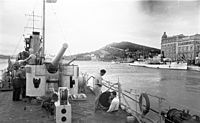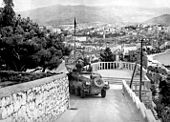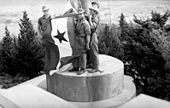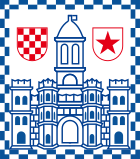By this time the population was largely Croatian,[30] while Romance Dalmatian names were not as common,[31] according to the Medieval city archives. The common language was Croatian, but Italian (a mixture of Tuscan and Venetian dialects) was also spoken due to Italiannotaries, school teachers and merchants.[32] The autonomy of the city was reduced: the highest authority was a prince and captain (conte e capitanio), always of Venetian birth.[33]
Split eventually developed into a significant port-city, with important trade routes to the Ottoman-held interior through the nearby Klis pass. Culture flourished as well, Split being the hometown of Marko Marulić, a classic Croatian author. Marulić's most acclaimed work, Judita(1501), was an epic poem about Judith and Holfernes, widely held to be the first modern work of Croatian literature. It was written in Split and printed in Venice in 1521.[34] Still, it should be noted the advances and achievements were reserved mostly for the aristocracy: the illiteracyrate was extremely high, mostly because Venetian rule showed little interest in educational and medical facilities.[citation needed]
In 1797 Split was ceded to the Habsburg Monarchy by the Treaty of Campo Formio, ending 377 years of Venetian rule in the city.[35]
Napoleonic wars[edit]
Split became part of the Napoleonic Kingdom of Italy in 1805, after the defeat of the Third Coalition at the Battle of Austerlitz and the consequent Treaty of Pressburg. It was included directly in the French Empire in 1806. The same year, Vincenzo Dandolo was namedprovveditore generale and general Auguste de Marmont was named military commander of Dalmatia.[36]
In 1809, after a brief war with France, Austria ceded Carinthia, Carniola, Croatia west of the Sava River, Gorizia and Trieste to France. These territories, along with Dalmatia, formed the Illyrian Provinces. During this period, large investments were undertaken in the city, new streets were built and parts of the ancient fortifications were removed.[37][38]
Austria, with help from a British force led by Captain William Hoste, occupied Split in November 1813.[39] Following the Congress of Vienna in 1815, the city was officially ceded to Austria.[40]
Under Habsburg rule[edit]
The Split region became part of the Kingdom of Dalmatia, a separate administrative unit. After the revolutions of 1848 as a result of theromantic nationalism, two factions appeared. One was the pro-Croatian Unionist faction (later called the "Puntari", "Pointers"), led by thePeople's Party and, to a lesser extent, the Party of Rights, both of which advocated the union of Dalmatia with the Kingdom of Croatia-Slavonia which was under Hungarian administration. This faction was strongest in Split, and used it as its headquarters. The other faction was the pro-Italian Autonomist faction (also known as the "Irredentist" faction), whose political goals varied from autonomy within the Austro-Hungarian Empire, to a political union with the Kingdom of Italy.
The political alliances in Split shifted over time. At first, the Unionists and Autonomists were allied against the centralism of Vienna. After a while, when the national question came to prominence, they separated. Under Austria, however, Split can generally be said to have stagnated. The great upheavals in Europe in 1848 gained no ground in Split, and the city did not rebel.
Antonio Bajamonti became Mayor of Split in 1860 and – except for a brief interruption during the period 1864–65 – held the post for over two decades until 1880. Bajamonti was also a member of the Dalmatian Sabor (1861–91) and the Austrian Chamber of Deputies (1867–70 and 1873–79). In 1882 the Bajamonti's party lost the elections and Dujam Rendić-Miočević, a prominent city lawyer, was elected to the post.
As part of Yugoslavia[edit]
Kingdom of Yugoslavia[edit]
After the end of World War I and the dissolution of Austria-Hungary, the province of Dalmatia, along with Split, became a part of the Kingdom of Serbs, Croats and Slovenes. Split was the site of a series of incidents between 1918 and 1920.
Since Rijeka, Trieste and Zadar, the three other large cities on the eastern Adriatic coast, were annexed by Italy, Split became the most important port in the Kingdom. The Lika railway, connecting Split to the rest of the country, was completed in 1925.
The country changed its name to the Kingdom of Yugoslavia in 1929, and the Port of Split became the seat of new administrative unit, Littoral Banovina. After the Cvetković-Maček agreement, Split became the part of new administrative unit (merging of Sava and Littoral Banovina plus some Croat populated areas), Banovina of Croatia in the Kingdom of Yugoslavia.
World War II[edit]
Main article: World War II in Yugoslavia
In April 1941, following the invasion of Yugoslavia by Nazi Germany, Split was occupied by Italy. Although Split formally became part of theIndependent State of Croatia, the Ustaše were not able to establish and strengthen their rule in Split, as Italians assumed all power in Dalmatia. One month later on 18 May 1941, when the Treaties of Rome were signed, Italy formally annexed Split and large parts of Dalmatia.[41] Italian rule met heavy opposition from the Croat population as Split became a centre of anti-fascist sentiment in Yugoslavia. The first armed resistance group was organized on 7 May 1941; the 63 member strong 1st Strike Detachment (Prvi udarni odred) served as the basis for future formations, including the 1st Split Partisan Detachment.[42] Between September and October 1941 alone, ten officials of the Italian fascist occupation were assassinated by the citizens.[43] On 12 June 1942, a mob, which included Italian soldiers, devastated the city's synagogue, attacked the Jews inside, and looted sixty Jewish homes.[44] In September 1943, following the capitulation of Italy, the city was temporarily controlled by Tito's brigades with thousands of people volunteering to join the Partisans of Marshal Josip Broz Tito (a third of the total population, according to some sources). A few weeks later, however, the Partisans were forced into retreat as the Wehrmacht placed the city under the authority of the Independent State of Croatia a few weeks later. The local football clubs refused to compete in the Italian championship; HNK Hajduk and RNK Splitsuspended their activities and both joined the Partisans along with their entire staff after the Italian capitulation provided the opportunity. Soon after Hajduk became the official football club of the Partisan movement.
In a tragic turn of events, besides being bombed by axis forces, the city was also bombed by the Allies, causing hundreds of deaths. Partisans finally captured the city on 26 October 1944 and instituted it as the provisional capital of Croatia. On 12 February 1945 the Kriegsmarine conducted a daring raid on the Split harbour, damaging the British cruiser Delhi.
| Second Occupation | ||||||||||||
|---|---|---|---|---|---|---|---|---|---|---|---|---|
|
Federal Yugoslavia[edit]
Main articles: Socialist Federal Republic of Yugoslavia and Socialist Republic of Croatia
| This section does not cite any sources. (November 2014) (Learn how and when to remove this template message) |
After World War II, Split became a part of the Socialist Republic of Croatia, itself a constituent sovereign republic of the Socialist Federal Republic of Yugoslavia. During the period the city experienced its largest economic and demographic boom. Dozens of new factories and companies were founded with the city population tripling during the period. The city became the economic centre of an area exceeding the borders of Croatia and was flooded by waves of rural migrants from the undeveloped hinterland who found employment in the newly established industry, as part of large-scaleindustrialization and investment by the Yugoslav Federal Government.[citation needed]
The shipbuilding industry was particularly successful and Yugoslavia, with its Croatian shipyards, became one of the world's top nations in the field. Many recreational facilities were also constructed with federal funding, especially for the 1979 Mediterranean Games, such as the Poljud Stadium. The city also became the largest passenger and military port in Yugoslavia, housing the headquarters of the Yugoslav Navy (Jugoslavenska ratna mornarica, JRM) and the Army's Coastal Military District (equivalent of a field army). In the period between 1945 and 1990, the city was transformed and expanded, taking up the vast majority of the Split peninsula. In the same period it achieved an as yet unsurpassed GDP and employment level, still above the present day's, growing into a significant Yugoslav city.[citation needed]












No comments:
Post a Comment